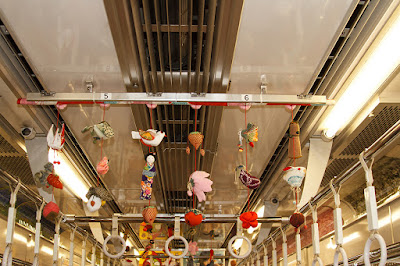If you ever experienced using public transportation in Japan, whether good or bad, you must admit it is efficient. I'll only scratch the surface in this blog, but I could write a book on this topic. One of the things that make it efficient is the PASMO / SUICA cards. They are a prepaid debit card. Simply place the card over an electronic reader and it automatically deducts the charge. (More on this in my subway portion of the blog.) These can be used on the public transportation systems to include taxis, vending machines; and at some shops such as the convenience stores.
I live in the U.S., it is almost a requirement to own a car, particularly in the rural areas. There are a few exceptions, such as if you reside in a large city, then public transportation can be a viable option. It is just the opposite in Japan. In every major city, it is convenient to move around using public transportation. Traveling by car, seems more like a burden than a convenience. Between traffic jams and finding a place to park, why bother; when the train, subway, bus, taxi or a combination of all, will get you where you want to go in a short amount of time.
The Train: In the above video is a time-lapse of an arriving train. Although this is the Chuo Line the Yamanote Line is one of Tokyo's busiest. One of the most fascinating things about the Yamanote Line is the different jingles that play at each station. There are 30 stations, so I would deduce there are 30 different jungles. One of my favorites is the Ebisu Jingle. If you are interested in seeing a YouTube video about the music, and musician behind the scenes, check out this link Train Jingles
Speaking of Trains - The Shinkansen: How fast do you want to go? Well the speed varies depending on which line you are taking. According to the JR Shinkansen Website trains reach a top speed of 320 km/h or 199 mph, but they are known to have traveled up to 515 km/h or 320 mph.
I have had the opportunity to ride various trains, from the shinkansen to local trains, and everything in between. I can say with certainty that Japan has a fascination with trains.
The Subway: This is the star of the show. The Tokyo Subway System at first may seem like a labyrinth. It is a complex system that is interwoven with passageways, entrances, and exits, and a few ups and downs; but there is a method to the madness. It's called organized chaos. I hope I haven't dissuaded you from experiencing the subway. The really interesting thing about the subway is each station has its' own character. For example the Azabu-Juban station is a deep subway. The escalator descends 48 meters (157 feet) deep, one of the deepest subways in Tokyo. I previously mentioned the PASMO/SUICA card. Many years ago my wife, an old school Tokyoite, decided we should purchase a PASMO card. We charged the cards and were ready to use them. One of us put the card in the slot for tickets instead of placing it over the scanner. Needles to say the station master was not very happy. His look of disgust said it all. He was able to open the top of the machine and gave us back our PASMO. No harm no foul. Right?
The Taxi: Taxi's in Tokyo are plentiful. No need to call on the phone and request one, simply hail the taxi from the side of the road. So convenient there is a light in the front window that will show if the taxi is available, "Red" or "Green", if occupied. They are also equipped with an automatic door opener, on the left side, so you will not need to open or close the door. Taxi's can be expensive though.
The Bus: I have a photograph of just about everything, except a bus. Not sure why. But this is another form of transportation, that shouldn't be neglected. Although the seats are small, even for a little man like me, there is a system to riding the bus. If there is standing room only move as far to the back as possible. Enter through the front door and exit from the back. If you are not close to the door and you want to get off, a few Sumimasen will get you out the door.
The Bicycle: If all else fails the good old bicycle is standing by to get you from point A to point B. Equipped with baskets and a bell to let pedestrians know you are passing them; or in my case move over, get out of the way. It may be an unwritten rule, but if you are walking, walk on the left side.
And there you have it. This is a brief synopsis of the Tokyo transportation methods. I could have went into greater detail but then that would take the fun out of experiencing getting around Tokyo by Train, bus, taxi or bicycle.




Comments
Post a Comment